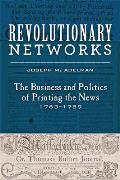Tapping into Revolutionary Networks
At the Junto blog, Jordan E. Taylor interviewed Framingham State professor Joseph Adelman about his new book, Revolutionary Networks: The Business and Politics of Printing the News, 1763–1789.
Many books have studied the political printing of the Revolutionary era through biography of exceptional figures like Benjamin Franklin or Isaiah Thomas, or through studies of how political essays were written and spread. But how ordinary printers did the work to put those essays into readers’ hands hasn’t gotten so much attention.
Adelman told Taylor:
Many books have studied the political printing of the Revolutionary era through biography of exceptional figures like Benjamin Franklin or Isaiah Thomas, or through studies of how political essays were written and spread. But how ordinary printers did the work to put those essays into readers’ hands hasn’t gotten so much attention.
Adelman told Taylor:
To understand the materiality of these texts and how they operated in the real world, it is helpful to actually see them in physical form. In the introduction I work through how printers laid out a weekly newspaper, which is difficult to see through a view of single pages in PDF form. I also was able to see (literally!) some important developments in newspaper runs by being able to see the size and quality of the paper, for example. . . .Here’s how Adelman described the main argument of Revolutionary Networks:
As for my favorite find, I’d have to say the story from the Stamp Act crisis about Boston radicals who in February 1766 tried a piece of stamped paper for treason and then ceremonially hanged and burned it. It may be my favorite story of the entire Revolution, both because it’s so Boston and because it encapsulates so much about how Americans in the 1760s viewed print and paper (it could commit crimes!).
Much of the book examines how printers (and their collaborators) created both formal and informal mechanisms to circulate news and information, through the post office, committees, and the networks that printers developed—with one another, with political leaders, with economic elites, and others.Taylor’s review of Revolutionary Networks for the Junto is here. We can also hear Joe Adelman speaking about his book on the podcasts Ben Franklin’s World and New Books in American Studies.
A second thread that runs through the book is the changing conception of freedom of the press, and especially its relationship to the business practices of the printing trade. Dating back to the early eighteenth century and Benjamin Franklin’s “Apology for Printers,” printers portrayed themselves as mechanics who set type and pulled the press, but remained outside of the political debate. The Revolution brought that to an end. Independence also forced printers, and political leaders to reframe their thinking about the press from its position as opposition against a distant government to its standing as a constituent part of the new republics.
Finally, the thing that ties everything together is the overlap between commercial and political interests. It seems a truism to say that out loud, but for printers those concerns interacted in complicated ways, both across the group as a whole and for individuals over time.


No comments:
Post a Comment